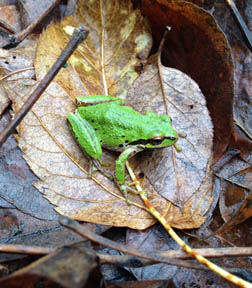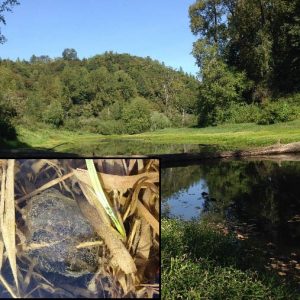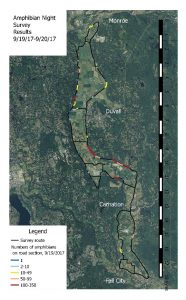Citizen Scientist Monitoring and Amphibian Study at Oxbow
Oxbow Farm & Conservation Center and Woodland Park Zoo work with citizens to study and conserve amphibian populations
Frogs and salamanders don’t garner the same respect as our returning salmon or draw tourists like a convocation of bald eagles, but scientists and citizens alike are waking up to their ecological importance. Amphibians, the group that includes frogs and salamanders, also have an important place in our experience of nature. Just ask any child who has caught frogs along the banks of a pond on a summer day.

People who live near ponds or wet fields in the Snoqualmie Valley can attest to the abundance of northern Pacific tree frogs, whose “krr-eck, krr-eck” calls ring across warm late winter and spring evenings. Salamanders, newts, and some species of frog, on the other hand, are quieter and hide themselves beneath leaf litter for much of the year. For this reason, even biologists have been surprised by recent studies assessing the natural abundance of salamanders in forests, which show us that there may be 9,000 or more salamanders per acre of forest in some parts of the country. These numbers underscore the importance of amphibians as prey for eagles and herons, coyotes and raccoons. On the flip side, amphibians play a role in controlling insect populations, and they may even play an important role in a forest’s ability to sequester carbon.

Despite their low profile (literally and figuratively), these little creatures are beginning to get more attention in western Washington. The increased attention here and elsewhere is due in part to several growing threats. One threat is ongoing habitat loss and alteration from logging and development, which leaves fewer and fewer forested places for adult amphibians to forage and hide. Another growing threat is infection by an invasive fungus of the chytrid group, Batrachochytrium dendrobatidis, which has decimated amphibian populations in many parts of the world over the last 20-30 years.
Two current projects, one directed by Woodland Park Zoo in Seattle and one being carried out by Oxbow Farm & Conservation Center, are good examples of local research that involves citizen scientists and landowners. To help keep an eye on our western Washington populations, Woodland Park Zoo (partnering with Washington Department of Fish and Wildlife) is recruiting citizen scientists to join an increasingly popular amphibian monitoring program.
Every year, volunteers young and old sign up to monitor a wetland near their home, walking along the margins of their chosen pond once a month from February to July and carefully observing and documenting eggs, tadpoles, and adult frogs and salamanders. The project utilizes iNaturalist, which enables users to visualize regional biodiversity, share observations with the community, and get data verified by scientists. In its sixth year, the Amphibian Monitoring program is collecting long-term data that can be used by land managers, WDFW, the zoo, and other organizations to better understand local amphibian populations.

Another study of amphibians launched by Oxbow, with support from Conservation Research and Education Opportunities, focuses specifically on the amphibians of the Snoqualmie Valley and looks at the potential impacts of roads on these species. Many common amphibians in our region migrate seasonally between breeding ponds, where they can be heard or seen congregating in the late winter and spring, and their winter forest habitat, where they usually wait out the cold weather under a blanket of leaves. If a road runs between these seasonal habitats, it can keep amphibians from making the journey or weaken the population through an annual toll of roadkill. Initial road surveys in the valley show that, indeed, hundreds of amphibians (mostly tree frogs) are killed on the most active nights of migration.
Every month during the late winter and spring of 2018, Oxbow researchers will survey a sample of breeding ponds to see what species are supported by the many Snoqualmie Valley ponds and sloughs, and to assess whether ponds divided from wintering habitat by busy roads have fewer frogs and salamanders. Together, the road and pond surveys will give a picture of where amphibians are trying to cross roads and whether they are more successful where roads are absent or less-traveled. This kind of information is the first step in assessing the need for and efficacy of road-crossing tunnels, structures that have been used successfully in other parts of the country to reduce amphibian road mortality. For now, we’re excited to begin to get a better sense of how amphibians are using and moving across our changing landscape.
If you’d like to join Woodland Park Zoo’s amphibian monitoring program, take a look at their citizen science webpage. If you are interested in learning more about the Oxbow study, or you are a Snoqualmie Valley landowner and are interested in learning more about the diversity of amphibians on your land, please contact Matt Distler, Oxbow Staff Ecologist, at matt@oxbow.org.
